What’s your company’s return policy?
I’m sure you’ve been asked this question before by both current and prospective customers.
But think about when this question gets asked. It’s not just when someone wants to return an item. Customers want to know what your return policy is before they buy.
This holds true for in-store and ecommerce purchases. In fact, 90% of consumers read return policies before making a purchase online.
Obviously, you don’t want to get frequent returns.
But knowing that returns are easy and hassle-free will make it more likely that customers will complete the purchase process.
Friendly return policies will improve your customer service. It shows everyone that you stand behind your products.
If everything you’re selling is a final sale, it’s an unreasonable and questionable business practice. This will make customers think twice before buying.
Some of you may not have thought of these ideas before you came up with your existing return policy. That’s why I created this guide.
Whether you’re developing a return policy from scratch or wishing to change your current policy, you’ll benefit from these tips.
The adjustments will make your product or service more desirable for consumers to buy.
Provide free returns
I realize that returns can potentially cost your company some money. But you need to weigh that expense against the price of potentially losing a customer.
Do not charge customers for returns even if they need to ship an item back to you.
That money isn’t worth losing a customer over.
Put yourself in the shoes of a consumer. There’s a reason why they are returning an item.
It was unsatisfactory in some way. Maybe it was damaged, or it looks different from what they saw online. You could have made a mistake and potentially sent the wrong item.
Regardless of the reason, they are already inconvenienced. Don’t make them pay to give it back to you.
Free return policies encourage shoppers to buy products online.
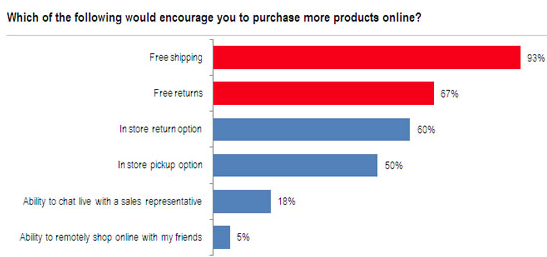
As you can see from the graph, this was a top motivating factor, second only to free shipping.
Studies show that 27% of consumers say they would buy an item that costs more than $1,000 if the store offers free returns.
Just 10% of buyers would do the same without free returns.
Think about that. These customers are willing to spend $1,000 or more. You want to make sure you keep their business and encourage them to buy.
If they want to return something and it costs you a few extra bucks, so what?
The value of that customer will make up for it over time.
Offer a free trial
Usually, free trials are associated with subscription services. But you can implement this strategy even if your business sells physical products.
Here’s how it works.
Rather than having someone buy something and then return it, let them try it free and leave it up to them whether they want to keep the item or not. It’s not exactly the same as a free trial you’re used to, but the concepts are the same.
Basically, it’s a risk-free way for consumers to experience your product.
Here’s an example from Warby Parker:
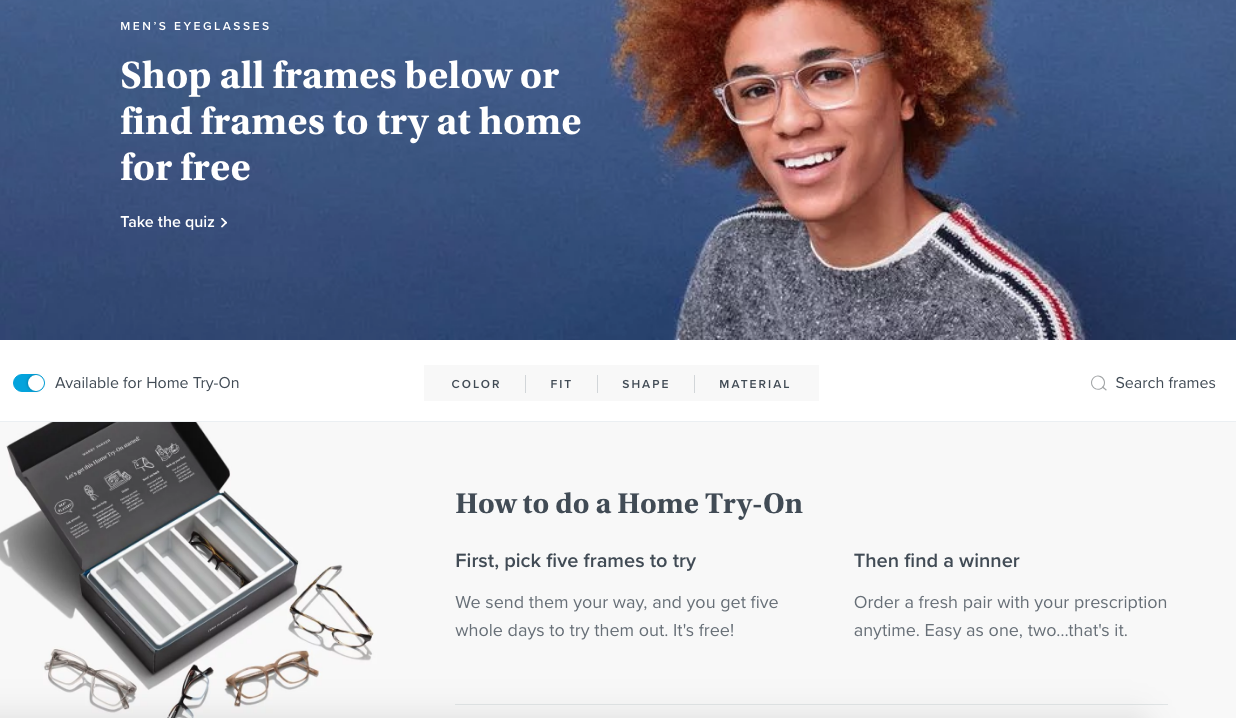
Glasses need to be tried on before a decision about them can be made.
In most instances, it’s difficult to order well-fitting glasses online without trying them on in person. But Warby Parker makes this easy for its customers.
It allows people to order five different frames, shipping them to the customers’ homes at no cost.
Customers can test them to see which ones fit and look the best. Then, they send back the ones they don’t want and get charged for whatever they keep.
It’s brilliant.
This strategy will result not only in more sales but also in increase in the average order value of each purchase.
The customer already has products in their possession. At this point, they may end up wanting two pairs instead of one.
The main benefit of shopping in stores compared to online is getting to see, touch, feel, and try on products. But if you can provide your customers with the same experience from the comfort of their homes, it will give you a huge advantage.
I definitely recommend this strategy, especially to ecommerce shops.
Make the return process as easy as possible
You should apply the same concepts to your return procedure as you do to your checkout process.
The fewer steps a customer has to go through, the higher your conversion rates will be.
Again, it’s not like you want to have lots of returns. But they are bound to happen.
In fact, 30% of products ordered from ecommerce shops get returned compared to just 9% to those from physical stores.
And 92% of consumers will buy from a store again in the future if they experience an easy return process.
Here’s Zappos’ return policy:

The return process consists of three simple steps.
The website includes a picture and description of each step. Zappos even has an option for people to find the nearest UPS shipping center to drop off the package they are returning.
This added value goes a long way.
Even though the customer physically has to go to a UPS center to return their order, the friction has been reduced.
Otherwise, the customer would have to open a new browsing window, search for UPS, and find a location nearby. That’s three extra steps.
If you can eliminate the hassle in your return process, people will be more likely to buy.
Don’t restrict return methods
Give your customers as many options as possible when it comes to returning items.
Let’s say you have multiple store locations. If a customer buys something at one location, they shouldn’t have to go back to that exact store to make a return.
Your system should make it possible for returns to be accepted at every location, regardless of where something was purchased.
It’s for the customer’s convenience. You don’t know the circumstances behind the sale.
Customers could be traveling away from home or be on vacation. In this case, it would be unrealistic for a customer to return to an exact store if they live hours away or potentially in another state.
In this case, they would be less likely to buy something if they knew it could only be returned at one location.
Let’s take this concept one step further. Online orders should be accepted as in-store returns as well.
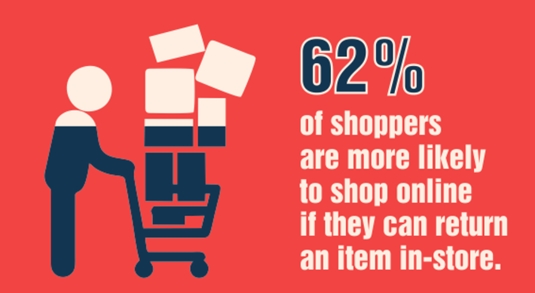
Maybe the customer doesn’t want to deal with shipping, even if you made the process easy as in the previous example.
But the fewer restrictions you have, the easier it will be for your customer.
People will be more likely to buy knowing they have options if they decided to return something.
Showcase your return policy
I already talked about the fact that customers will review a return policy before making a purchase online.
Don’t make them hunt for your policy on the website. If your return policy is buried somewhere, it’s going to be difficult to find.
I’m not saying you need to have the return policy displayed in its entirety on every page, but at least highlight the benefits.
Here’s an example of how Lululemon does this on its homepage:
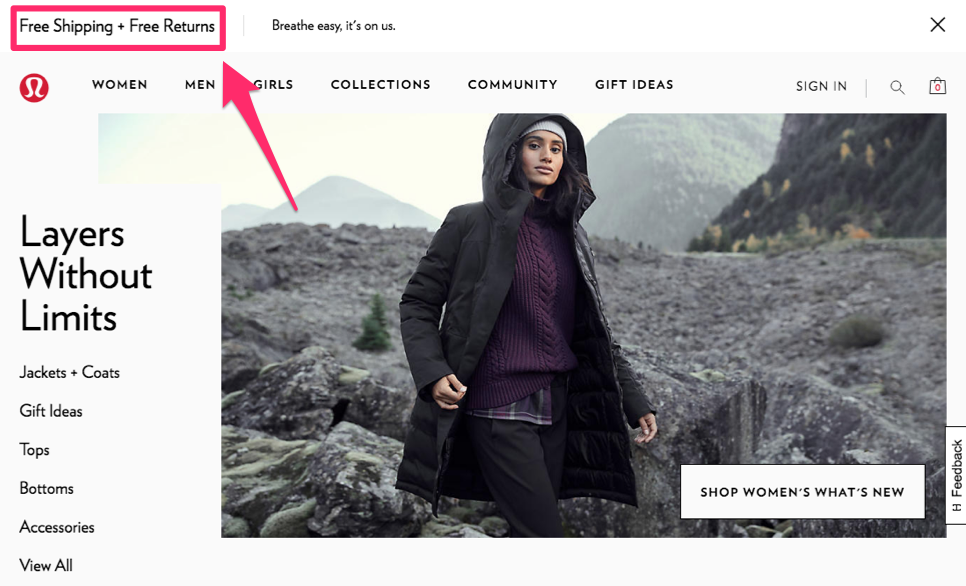
Remember the graph you saw earlier about the top two factors that encourage people to buy online?
Free shipping and free returns.
As soon as a visitor navigates to this website, they know returns are free.
They can click on it to review the policy in greater detail, but at least they don’t have to go searching for it.
That’s how you design a homepage that converts.
Stand behind your product
What happens when one of your products has been opened, had the tags removed, or had been worn or used? Can the customer still return it?
If the answer is no, you might have a harder time generating sales.
Sometimes, consumers won’t know whether they are happy with an item until they had the chance to use it.
If you stand behind your product and offer returns on used items, consumers will be more likely to buy.
Here’s an example from SAXX:
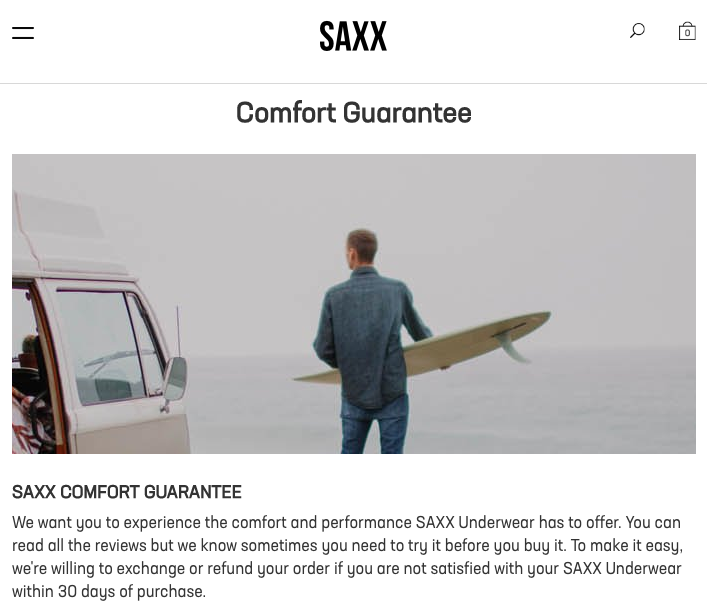
I’m not saying you should accept an item after it’s been used for a year and is now worn out.
But the comfort guarantee from SAXX is very reasonable and something you might want to consider implementing in your business.
30 days, or your money back.
This gives its customers a chance to try the underwear, which is the only way someone can truly know whether they are happy with it or not.
If someone is unhappy, SAXX will exchange the item or refund the purchase.
Obviously, you would prefer a product exchange, but you should still offer a refund as an option. Don’t make it seem as if you’re holding their money hostage.
Provide easy access to customer support
Before someone wants to return something, they may have questions that can be answered by your customer support team.
The customer may want to learn more about the policy, find out what their options are, or just talk to someone about their dissatisfaction.
Regardless of the reason, you want to make this process as easy as possible.
You need to understand what people want when it comes to customer support:

Customers have different preferences.
You need to be available through as many communication platforms as possible, such as:
- phone
- live chat
- social media
- in person
Further, you don’t always have to stick to your exact return policy. Exceptions can be made. Let me explain what I mean.
The fans of the TV series Seinfeld may be familiar with an episode in which Jerry wants to return a jacket he bought.
The customer service representative asks why he wants to return it, and Jerry says he’s returning it out of spite because he doesn’t care for the salesman who sold it to him.
So the store manager tells Jerry that spite doesn’t meet the conditions for a return.
Obviously, it’s a show and meant to be humorous. But let’s look at a more realistic example.
If you have a return policy similar to the earlier SAXX example, customers can return an item within 30 days of the purchase, even if it’s been worn.
Well, what happens if someone contacts customer support on day 33 asking for a return? Is the answer no?
Exceptions can be made. Hear them out.
Maybe they are just now trying it on for the first time. Instead of refunding their money, at least give them a store credit or offer an exchange.
Your staff needs to be trained accordingly to handle these circumstances.
As I said before, it’s not worth it to lose a customer over this.
They want to return something that was used and cost $50. I get it. This is not ideal for your company.
But if that customer is going to spend more than that in the future, it’s worth it to make an exception by providing customer service that’s reasonable and easily accessible.
Extend the return deadline
This is similar to my last point.
You can avoid the above circumstances from arising if you extend the return deadline to begin with.
Here’s a great example from Target:
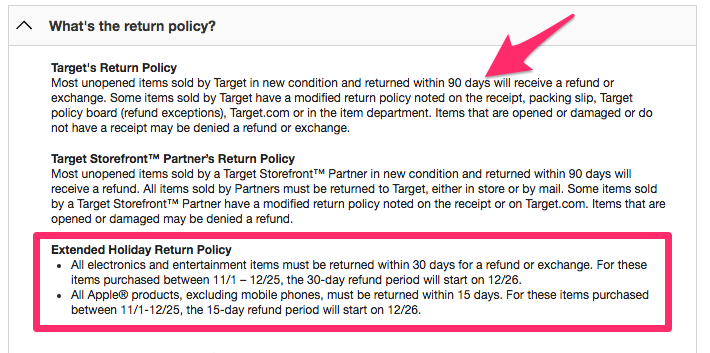
Customers have 90 days to return items.
Target extends its return policy during the holiday season. It recognizes customers are buying for other people, and items might not be seen or opened by the final user right away.
The policy starts on 12/26 if an item was purchased between 11/1 and 12/25.
This is a great way to drive sales during the holiday season.
Do you remember I said you should make exceptions? Well, Target has a separate section of its return policy that addresses exceptions:

One of my favorites is the first one on the list, which is shown above.
You can bring back anything within one year and get an exchange or refund if it’s a Target-owned brand item.
This type of extended policy makes it really enticing for a customer to buy from the store.
Conclusion
Your return policy is much more important than you might think. Customers take this into consideration when deciding whether they’re going to make a purchase or not.
That’s why you need to offer free returns.
Set up a trial system allowing people to try products you sell online before the sale is finalized.
Returns need to be as easy as possible. Give customers lots of options so they can choose a return method convenient to them.
Your return policy should be easy to find on your website.
Stand behind your products. Make sure it’s easy for people to reach a customer service representative.
Extending the deadline of returns from the purchase date gives customers an added incentive to buy.
You don’t want to encourage returns. But changing your return policy will help you generate sales. Use this guide as a reference to implement changes.
What return policy does your business offer, and will you make changes to it in the near future?
from Quick Sprout https://ift.tt/2GpWygC
via IFTTT